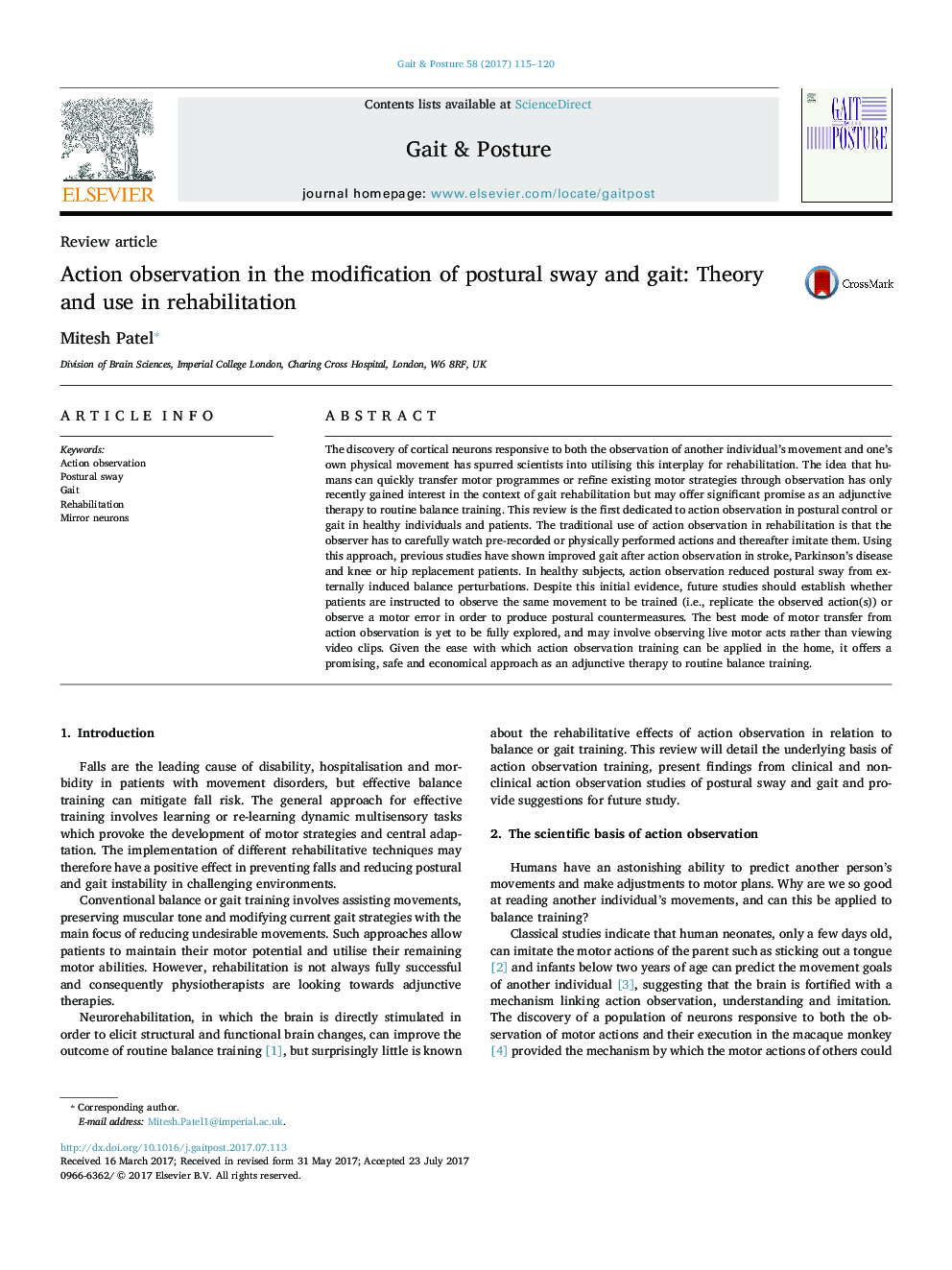| کد مقاله | کد نشریه | سال انتشار | مقاله انگلیسی | نسخه تمام متن |
|---|---|---|---|---|
| 5707584 | 1603837 | 2017 | 6 صفحه PDF | دانلود رایگان |
عنوان انگلیسی مقاله ISI
Action observation in the modification of postural sway and gait: Theory and use in rehabilitation
ترجمه فارسی عنوان
مشاهده فعالیت در اصلاح گشت و گذار موقعیت: نظریه و استفاده در توانبخشی
دانلود مقاله + سفارش ترجمه
دانلود مقاله ISI انگلیسی
رایگان برای ایرانیان
کلمات کلیدی
مشاهده فعالیت پست مدرن، راه رفتن، توانبخشی، نورونهای آینه،
ترجمه چکیده
کشف نورونهای کورتنی که به دنبال مشاهده جنبش فرد دیگری و جنبش فیزیکی خود است، موجب شده است دانشمندان به استفاده از این تعامل برای توانبخشی کمک کنند. این ایده که انسان ها می توانند به سرعت برنامه های حرکتی را تغییر دهند یا راهکارهای موجود موتور را با استفاده از مشاهدات تصحیح کنند، اخیرا علاقه مند به زمینه توانبخشی راه رفتن بوده اند اما ممکن است وعده های قابل توجهی را به عنوان یک درمان اضافی برای آموزش تعادل روتین ارائه دهد. این بررسی اولین مورد برای مشاهده عمل در کنترل پوسیدگی و یا راه رفتن در افراد سالم و بیماران است. استفاده سنتی از مشاهدات عمل در توانبخشی این است که ناظر باید با دقت از اقدامات پیشگیرانه یا جسمی انجام شده و سپس آنها را تقلید کند. با استفاده از این رویکرد، مطالعات قبلی نشان داده اند که راه رفتن بهبود یافته پس از مشاهده فعالیت در سکته مغزی، بیماری پارکینسون و بیماران جایگزین زانو یا لگن. در افراد سالم، مشاهده عملکرد، مانع ظاهری از اختلالات توازن ناشی از خارج شد. علیرغم این شواهد اولیه، مطالعات آینده باید تعیین کنند که آیا بیماران آموزش دیده اند تا همان حرکت را آموزش ببینند (به عنوان مثال، تکرار اقدامات مشاهده شده) و یا خطای موتور را به منظور تولید اقدامات متقابل موضعی. بهترین روش انتقال موتور از مشاهدات عملی هنوز به طور کامل مورد بررسی قرار گرفته است و ممکن است به جای مشاهده کلیپ های ویدئویی، رعایت حرکات حرکتی باشد. با توجه به سهولت در انجام تمرینات نظارت بر عمل در خانه، این روش یک امیدوار کننده، ایمن و اقتصادی را به عنوان درمان اضافی برای آموزش تعادل روتین ارائه می دهد.
موضوعات مرتبط
علوم پزشکی و سلامت
پزشکی و دندانپزشکی
ارتوپدی، پزشکی ورزشی و توانبخشی
چکیده انگلیسی
The discovery of cortical neurons responsive to both the observation of another individual's movement and one's own physical movement has spurred scientists into utilising this interplay for rehabilitation. The idea that humans can quickly transfer motor programmes or refine existing motor strategies through observation has only recently gained interest in the context of gait rehabilitation but may offer significant promise as an adjunctive therapy to routine balance training. This review is the first dedicated to action observation in postural control or gait in healthy individuals and patients. The traditional use of action observation in rehabilitation is that the observer has to carefully watch pre-recorded or physically performed actions and thereafter imitate them. Using this approach, previous studies have shown improved gait after action observation in stroke, Parkinson's disease and knee or hip replacement patients. In healthy subjects, action observation reduced postural sway from externally induced balance perturbations. Despite this initial evidence, future studies should establish whether patients are instructed to observe the same movement to be trained (i.e., replicate the observed action(s)) or observe a motor error in order to produce postural countermeasures. The best mode of motor transfer from action observation is yet to be fully explored, and may involve observing live motor acts rather than viewing video clips. Given the ease with which action observation training can be applied in the home, it offers a promising, safe and economical approach as an adjunctive therapy to routine balance training.
ناشر
Database: Elsevier - ScienceDirect (ساینس دایرکت)
Journal: Gait & Posture - Volume 58, October 2017, Pages 115-120
Journal: Gait & Posture - Volume 58, October 2017, Pages 115-120
نویسندگان
Mitesh Patel,
